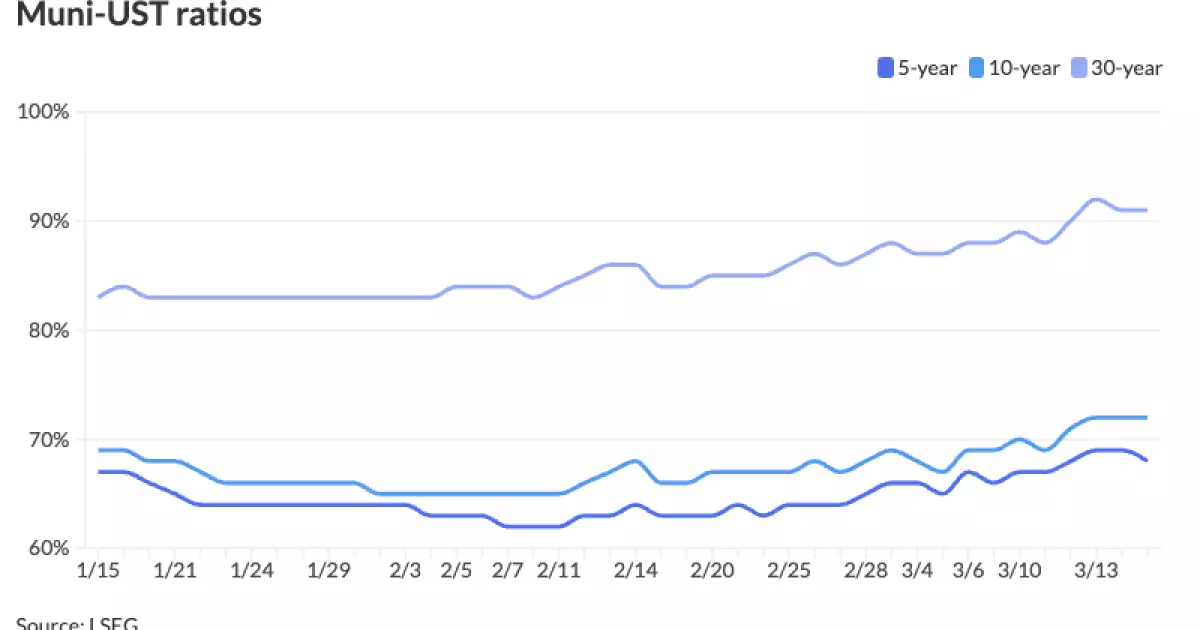The municipal bond market is currently navigating treacherous waters, teetering on the brink of volatility and uncertainty. Recent data indicate that municipals remain relatively unchanged, a troubling sign after last week’s pronounced tumult. The underlying factors that contributed to this market turbulence include supply overshadowing demand, disappointing consumer price index (CPI) data, and political threats that have instigated anxiety among investors. According to Jason Wong from AmeriVet Securities, current losses amount to 1.41% month-to-date, wiping nearly all gains from earlier in the year, an unsettling example of the fragile state of municipal securities.
It’s easy to overlook the implications of such statistics, yet it’s essential to consider them in a broader context. The municipal bond market, primarily serving as a funding source for local government projects—schools, parks, and utilities—is meant to be a bastion of stability. The recent sell-off, where municipal yields surged by an average of 15.1 basis points, coupled with reports of major upcoming layoffs and the speculation surrounding tariffs, lends credence to the notion that municipal bonds are not the safe haven they once were perceived to be.
The Ratios Speak Volumes
The ratios between municipal bonds and U.S. Treasuries (USTs) tell an unsettling story about the market’s health. As per the latest data from Municipal Market Data, the two-year municipal to UST ratio stands at 65%, while the long-term ratio is at a concerning 90%. Such low ratios mean that municipalities are increasingly perceived as higher-risk investments relative to federal securities, and this discrepancy should concern any conservative investor.
Dealing with cheap valuations is a double-edged sword. On one hand, it could represent a golden opportunity for savvy investors willing to endure the storm; on the other, it underscores a deeper instability within the market. The last year has seen long-dated municipal ratios hovering around 84%, with the current state being the cheapest since September 2024. An environment of stagnant demand, paired with dwindling resources, makes for a high-risk investment canyon that could swallow an unprepared market participant.
What Investors Should Watch For
Investors ought to heed the warning signs. Despite the distress signals, some buyers return tentatively, indicating that the market still holds potential. However, a stagnation in fund flows could lead to continued volatility. Recent reports indicate that municipal mutual funds witnessed a massive $373 million outflow, an alarming trend that can create a vicious cycle of falling demand and rising yields.
The implications are dire for municipalities relying on favorable bond markets to finance essential services and infrastructure projects. An active political backdrop, complete with tariff threats and economic stagnation, only amplifies these risks. If municipalities are compelled to increase yields significantly to attract investors, this could result in increased costs for projects, affecting public services and infrastructure investments down the line.
The Shifting Focus: Primary Market Dynamics
On the primary market front, issuances continue to rise year-over-year with a substantial 16.7% uptick—hitting just under the $100 billion mark. Yet this success is shadowed by skepticism; many analysts view it as a mirage in a desert of declining investor confidence. The primary market is expected to face challenges with mega offerings from reputable issuers like the Metropolitan Transportation Authority. While these offerings appear robust at $1.073 billion, they mask the underlying fragility of the broader market.
Pricing has become increasingly critical. The demand for competitively-priced new issues underscores that buyers are hunting for discounted bonds, forcing municipalities to accept less than favorable terms. If municipal bonds continue to come to market cheap, they may attract short-term interest, but the longer-term implications for stability are still uncertain.
The Hope Amidst the Gloom
Despite the chaos, experts like those from Birch Creek strategists suggest that those who dare to grasp cheap bonds during this time could find themselves handsomely rewarded in the long run. The idea of capitalizing on low yields during periods of uncertainty may sound counterintuitive, but it reflects an inherent optimism in the resilience of municipal bonds. Yet, this viewpoint is not universal. Many investors remain skeptical, and the volatile environment could lead to a significant reshuffling of priorities within municipal finance.
It is crucial to recognize that while the potential for reward exists, it comes with its own set of caveats. Short-term market resilience is often clouded by long-term risk; hence, prospective buyers must conduct thorough due diligence before entering this fraught landscape. The paradox of chasing potentially rewarding municipal investments amidst pervasive instability poses an ongoing challenge for any investor navigating the market today.

